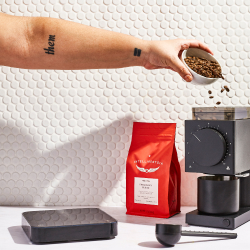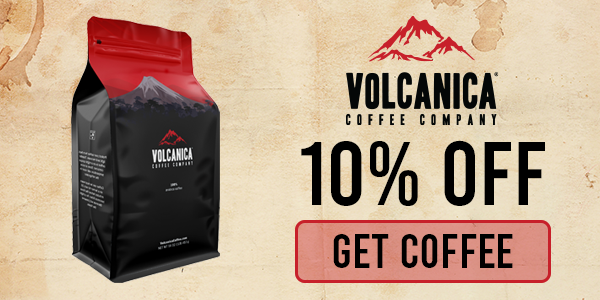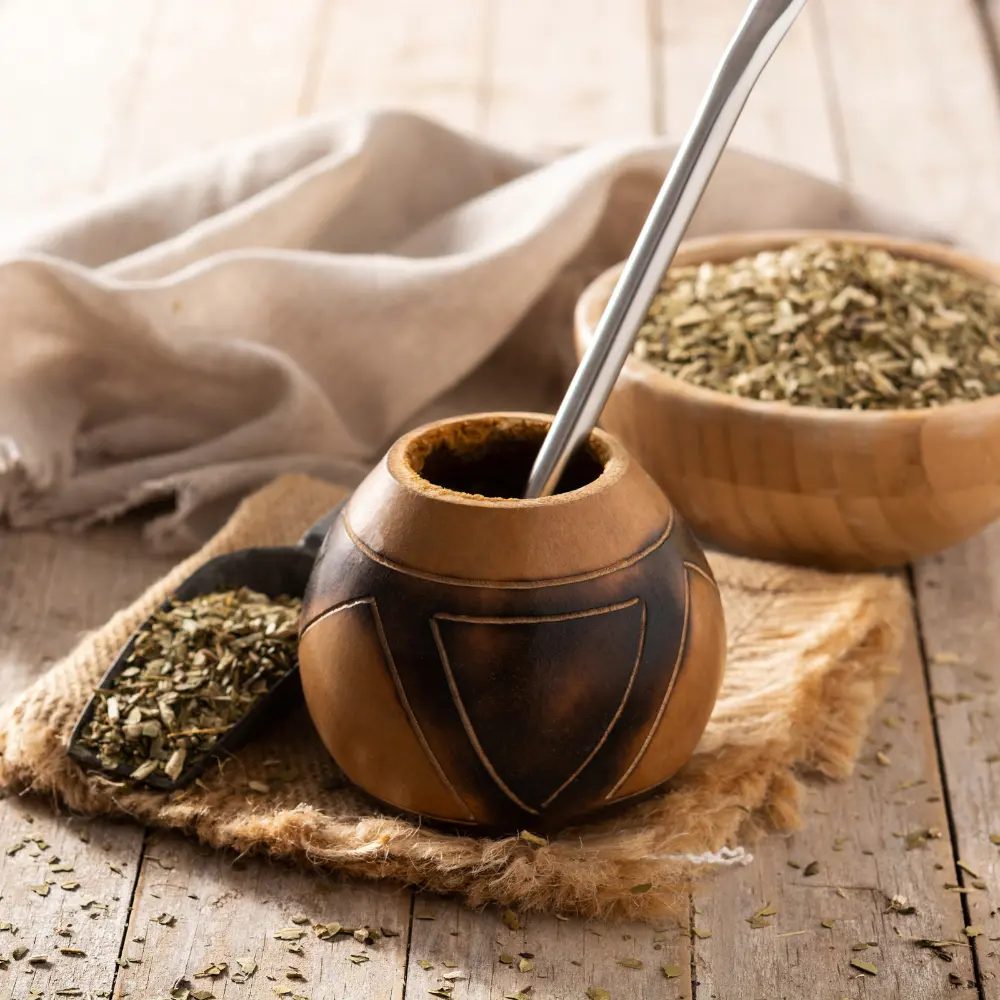As you plunge into the world of coffee culture, you may have found yourself asking: “What is cold brew coffee?” This unique method of brewing has gained significant traction in recent years, creating waves in the coffee community and beyond. Unlike the conventional hot brewing techniques, this refreshing variant involves steeping coffee grounds in cool water over an extended period, resulting in a beverage that is smooth, distinctive, and exceptionally suited to quench your thirst on those balmy summer days.
However, the appeal of this drink extends far beyond its capacity to cool you down. This delectable coffee carries a unique profile – a symphony of flavors and aromas that sets it apart from its hot-brewed counterparts. Furthermore, the reduced acidity and amplified notes of sweetness and chocolate make it a delight for those seeking a gentler, more nuanced experience.
The journey of discovering this beverage is as fascinating as the drink itself. Throughout this article, we will dive deep into the essence of this refreshing beverage- its history, the science behind the brewing process, its unique taste profile, and even tips on how to make this coffee at home. This exploration will bring you closer to understanding why this refreshing beverage has become the new ‘it’ drink and could very well revolutionize your coffee-drinking experience.
So, are you ready to immerse yourself in the enchanting world of this coffee drink? Let’s dive right in!
What is Cold Brew Coffee? – Key Takeaway
- Versatility and Variety: The world of this beverage extends beyond just a chilled coffee drink. With variations like iced, nitro, and concentrate, there are multiple ways to enjoy this refreshing brew, providing a thrilling journey of exploration for coffee lovers.
- Home Brewing: Crafting this drink at home is straightforward and satisfying. By controlling the grind size, brew time, and water temperature, you can customize the brew to your preferences and explore a range of flavors and profiles.
- Culinary Applications: This beverage has a significant place in the world of gastronomy. From enhancing the menu of modern coffee shops to being a key ingredient in innovative home recipes and sophisticated cocktails, it’s a versatile addition to any culinary experience.
- Specialized Brewing Equipment: There’s a range of specialized equipment available for making this drink at home, from compact and budget-friendly options to more sophisticated machines. Selecting the right one depends on your budget, space, and how much you plan to brew.
- Food Pairings: This beverage pairs wonderfully with a variety of foods. Understanding its flavor profile can enhance both your coffee and dining experiences, providing a delightful way to explore epicurean delights.
A Brief History of Cold Brew Coffee
Delving into the chronicles of any much-loved beverage often uncovers intriguing tales and this concoction is no exception. The journey of this drink is a captivating narrative that transcends continents and centuries, demonstrating the continual evolution of coffee culture. In this section, we’ll journey back in time to uncover the origins of this brewing method, trace its path to global popularity, and examine its significant impact on contemporary coffee culture. Ready to travel through the annals of coffee history? Let’s embark on this adventure.
The Origin and Evolution of Cold Brew

To trace the roots of this brewing method, we travel back several centuries to Kyoto, Japan. This unique approach to coffee preparation, referred to as ‘Kyoto-style coffee,’ dates back to the 1600s and is considered one of the earliest forms of making a cold coffee beverage. The Kyoto-style method, characterized by slow-drip brewing using cool water, became the precursor to modern-day cold brewing methods. With time, adaptations and refinements were made to this brewing technique, contributing to the rich, nuanced flavor profile we associate with today’s cold brew. (1)
The evolution of this beverage is a testament to the creativity and ingenuity of coffee enthusiasts worldwide. It reflects the continual quest for achieving an ever more refined flavor experience, challenging the norms, and pushing the boundaries of conventional coffee brewing.
Global Adaptation and Popularity
As the world started embracing different coffee cultures, this style of brewing began to find its way into coffee houses around the globe. In the early 20th century, Latin America, particularly Guatemala and El Salvador, saw a rise in the popularity of this brewing method due to its practicality in the hot climate.
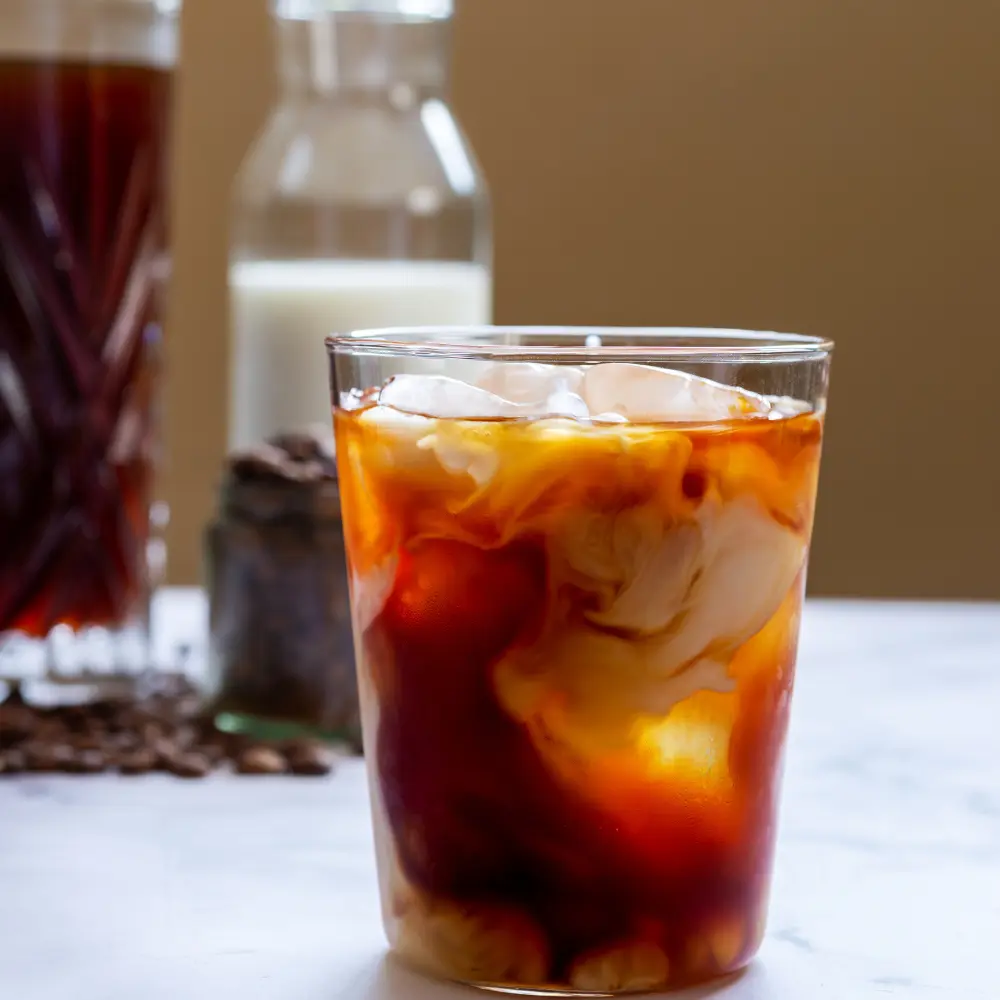
By the late 20th century, this beverage started to gain recognition in Western societies, particularly in the United States. Initially appearing in specialty coffee shops on the West Coast, the drink’s popularity quickly spread nationwide thanks to its distinct, smooth flavor profile and its refreshing qualities. The explosion of coffee culture in the 21st century further fueled its growth, with cafes and homes alike relishing the unique qualities of this cold delight.
Cold Brew in Contemporary Coffee Culture
In today’s dynamic coffee landscape, this brewing method has secured a firm spot. This is not just because of the unique flavor profile it offers, but also due to the versatility it brings to the table. Today’s coffee aficionados use it as a base for various coffee cocktails, infuse it into desserts, or enjoy it in its pure form over ice.
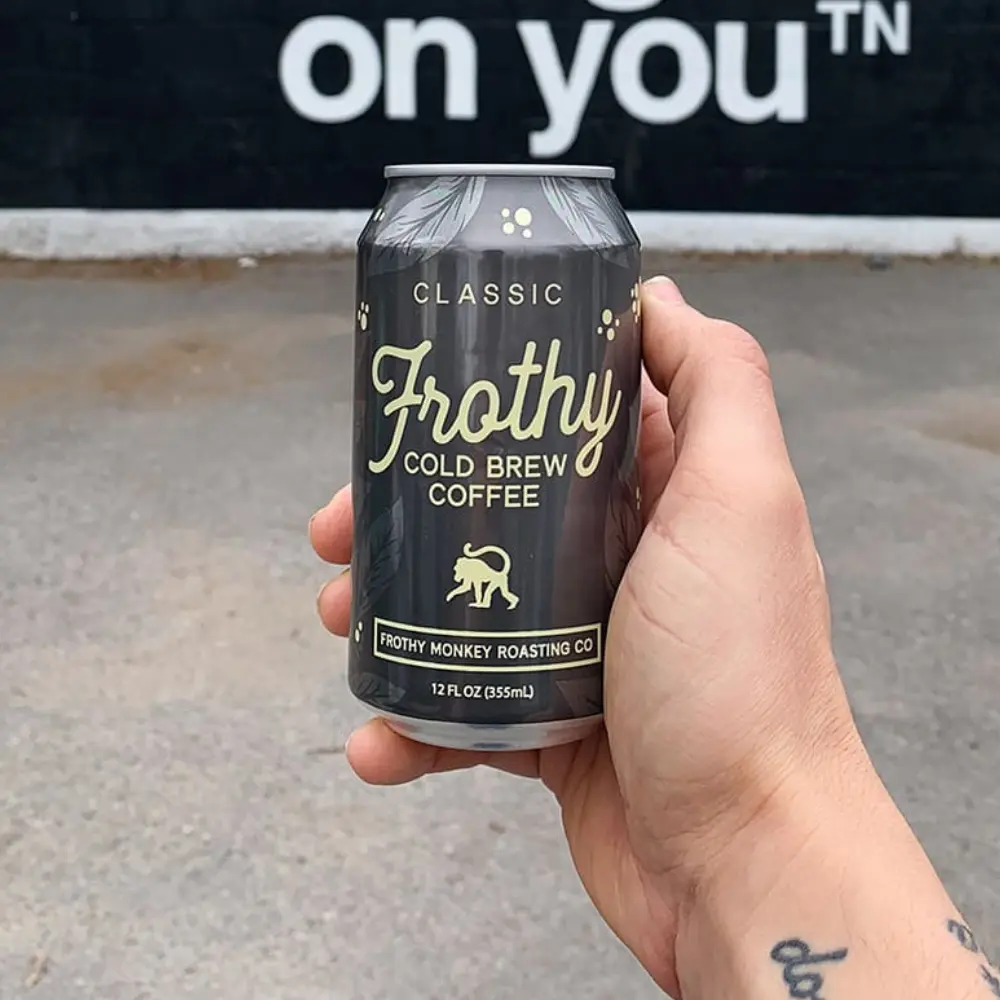
Its popularity has also prompted the rise of bottled versions, catering to the on-the-go lifestyle of modern consumers. Furthermore, it’s not uncommon to see baristas and coffee enthusiasts experimenting with different types of beans, roasts, and brewing times to perfect their version of this refreshing drink.
The integration of this brewing technique into contemporary coffee culture signifies not just a passing trend but an enduring shift in how we appreciate and consume coffee. It underlines the diversity and adaptability of coffee, proving that there’s always something new to learn and taste in this ever-evolving world.
Understanding Cold Brew Coffee
Beneath the cool, refreshing allure of this coffee drink lies an intriguing blend of science, technique, and unique taste profiles. This section aims to shed light on what sets this popular beverage apart from its traditional counterparts. From understanding the defining characteristics of this concoction to the underlying science of its brewing process, we’ll also delve into the unique taste profiles that distinguish this delightful drink. As we journey through these aspects, you’ll gain a deeper appreciation of the complexity and charm of this beverage. So, let’s dive in and quench our thirst for knowledge.
What Sets Cold Brew Apart: Understanding Its Unique Characteristics
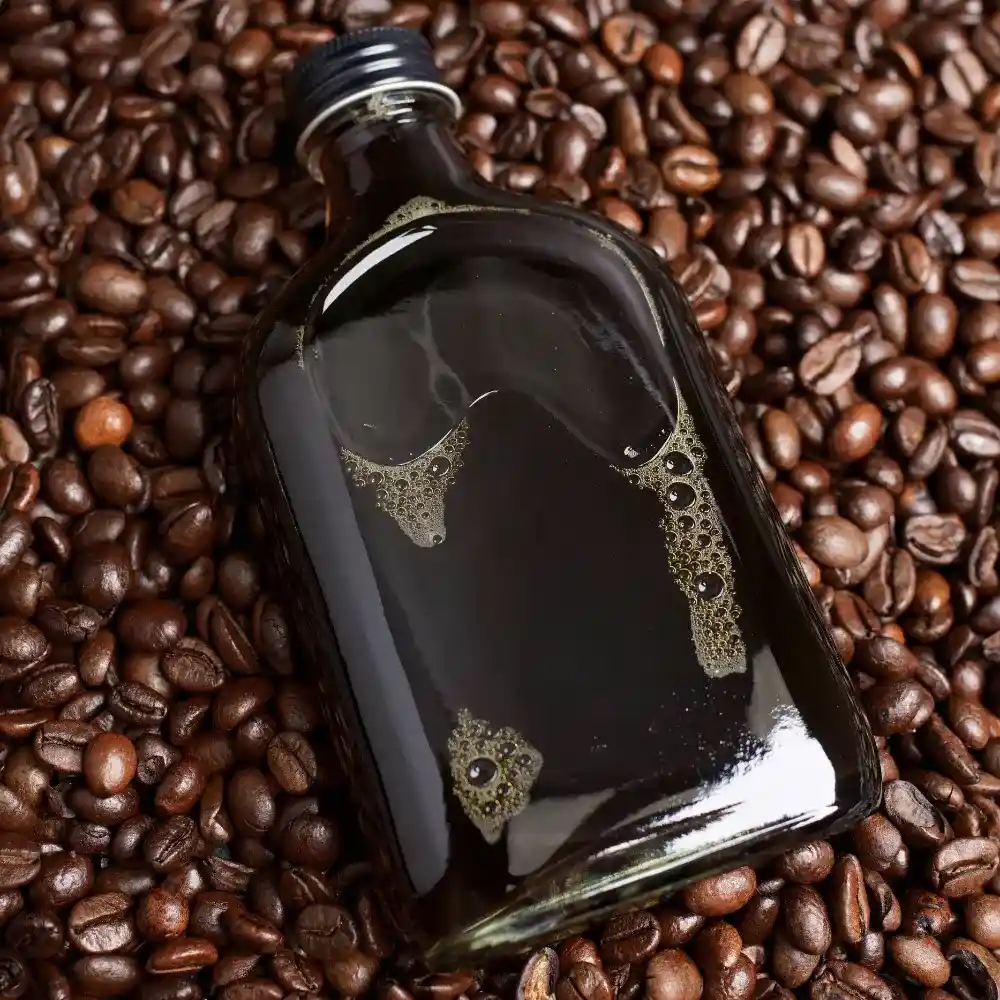
This brew boasts several unique characteristics that differentiate it from other brewing methods. The foremost is the brewing process itself. Unlike traditional coffee preparation that involves hot water, this drink is brewed with cool or room temperature water over an extended period, usually 12 to 24 hours.
This long, patient extraction process results in a beverage that is:
- Less Acidic: this beverage is up to 67% less acidic than hot-brewed coffee. This can lead to a smoother, creamier mouthfeel and make the drink more tolerable for those with acid sensitivity.
- More Caffeine-Packed: Due to the long steeping process, this beverage often contains more caffeine than your standard cup of coffee, making it a potent pick-me-up.
- Longer Shelf-Life: When properly stored, this coffee drink can remain fresh in the refrigerator for up to two weeks, offering a ready-to-serve option for coffee enthusiasts.
Cold Brew vs. Traditional Brewing Methods
When compared to traditional brewing methods, this technique stands apart not just in the brewing process but also in the final product’s flavor and texture. The brewing temperature and time significantly affect the extraction of flavors, acidity, and caffeine content.
Traditional brewing methods, such as the French Press or Pour-over, rely on hot water to extract coffee’s flavors quickly. However, these hot methods also extract more of the coffee’s acids and oils, which can lead to a more robust, sometimes bitter taste.

In contrast, this innovative brewing technique extracts flavors slowly and gently, reducing the amount of extracted acid and yielding a smoother, sweeter flavor profile. It results in a concentrated coffee that can be diluted with water or milk, providing flexibility in strength and flavor according to individual preference.
The Science of Cold Brewing
At the heart of this brewing method lies a fascinating science. This technique hinges on the principle of time over temperature. In simple terms, while hot water can extract coffee’s flavors quickly, cold water takes its time. This slow extraction process affects the chemical composition of the final beverage.
When coffee grounds come into contact with water, they start to release various compounds, including oils, acids, and aromatic molecules. However, many of these compounds are more soluble at higher temperatures. By using cold water, the extraction process is slowed down, reducing the release of acidic and bitter compounds and allowing for a more controlled extraction of desirable flavors and caffeine.
Taste Profile of Cold Brew Coffee
Now, let’s talk about flavor. The magic of this brewing process is reflected in the resultant taste profile of the drink. This brewing method tends to highlight the sweet, chocolatey, and fruity notes in coffee while dialing back on the bitterness.
Beyond the commonly recognized attributes of low acidity and smooth finish, this delightful coffee drink exhibits an array of complex and delightful flavor notes. Here are some distinct characteristics you might discern in a well-prepared cup:
- Subtle caramel undertones
- Notes of dark chocolate
- Hints of fruitiness, depending on the type of coffee beans used
- Deep, robust flavor owing to the concentration
- Smooth finish, without the ‘bite’ often associated with hot-brewed coffee
- Lack of pronounced bitterness
- Sweeter profile, often reducing the need for added sugar or sweeteners
- The greater complexity of flavor compared to iced coffee, which is typically just cooled down hot coffee.
The final product is a coffee concentrate that is inherently sweet, slightly nutty, and has a full-bodied, velvety mouthfeel. Its low acidity and smooth finish make it a refreshing and highly palatable choice, especially for those who find traditional coffee too harsh or acidic. This unique taste profile opens up new possibilities for coffee pairings and coffee-based recipes, making this drink a versatile addition to the coffee repertoire.
Benefits of Cold Brew Coffee
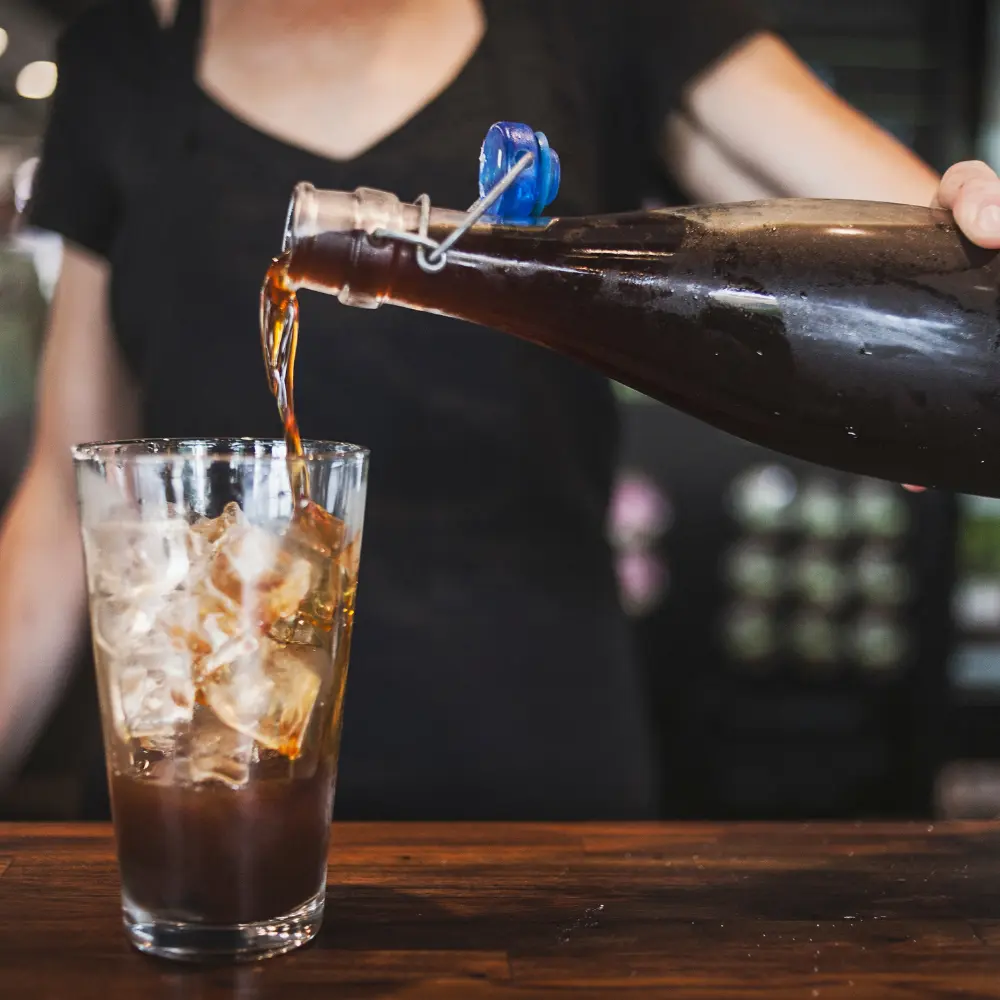
As we peel back the layers of this fascinating drink, we uncover a trove of benefits that extend beyond its delectable taste. From its gentle approach to coffee extraction that results in reduced acidity and bitterness, to the convenience it brings to coffee lovers, this concoction is as advantageous as it is enjoyable. We’ll also shed light on its health benefits and the subtle nutritional differences that set it apart from its hot-brewed counterparts. Let’s delve into these enticing benefits that have propelled this beverage to the spotlight in the coffee world.
Reduced Acidity and Bitterness
One of the most commendable benefits of this beverage lies in its gentle acidity profile. As discussed earlier, due to the cold water extraction process, this beverage releases fewer acidic compounds compared to hot-brewed coffee, making it up to 67% less acidic. This characteristic is a boon for individuals with a sensitive stomach or those who find the acidity of regular coffee too harsh.
Furthermore, the longer brewing process of this drink at lower temperatures results in a significant reduction of bitterness, highlighting instead the naturally sweet and complex flavors within the coffee beans.
Enhanced Flavor and Aroma
The unique preparation method of this drink offers an enhanced sensory experience, allowing for a better expression of flavor and aroma of the coffee. The slow and cold brewing process amplifies the subtle, often overlooked notes within the coffee, resulting in a rich, full-bodied flavor profile. It allows the coffee’s inherent sweetness to shine while reducing the dominance of bitter compounds.
Moreover, the aroma of this beverage is distinct, exuding softer and more nuanced fragrances compared to traditional coffee. This combination of flavors and aromas creates a sensory journey that is distinctive to this beverage.
Longer Shelf Life and Convenience
Another notable advantage of this drink is its extended shelf life. As mentioned before, while a typical hot-brewed coffee starts to lose its fresh flavor within a few hours, this delectable drink can be stored in the refrigerator for up to two weeks without losing its quality. This makes it a convenient choice for busy individuals or those who like to prepare their coffee in advance.
Moreover, the product of the cold brewing process is a concentrated coffee, which can be diluted with water or milk according to personal preference, further adding to the versatility and convenience of this drink.
Health Benefits and Nutritional Differences
This refreshing beverage isn’t just pleasing to the palate; it also brings along a handful of health benefits. As mentioned before, the reduction in coffee acidity can help minimize the digestive discomfort that some people experience with traditionally brewed coffee.

Furthermore, this brewing method may preserve more antioxidants, essential compounds that are linked to numerous health benefits, including heart health and decreased inflammation.
From a nutritional perspective, this coffee variant can contain more caffeine than hot-brewed coffee due to its higher coffee-to-water ratio. This means you might find yourself with a stronger caffeine kick, which can boost alertness and cognitive function. However, this varies significantly depending on the brewing time and the concentration of the final drink.
Overall, the benefits of this coffee drink extend beyond its refreshing taste, making it a versatile, enjoyable, and health-conscious choice for coffee lovers.
How to Make Cold Brew Coffee
While the enjoyment of this beverage is a delightful sensory experience, the process of making it is an art form in its own right. With just a few basic pieces of equipment and a touch of patience, you can become your own barista and learn how to make this coffee right in the comfort of your own home. From understanding the essential tools for this brewing technique to following a simple step-by-step guide, we’ll also share some valuable tips to perfect your technique. Are you ready to master the art of brewing your own cold coffee? Let’s dive in!
Essential Equipment for Cold Brewing
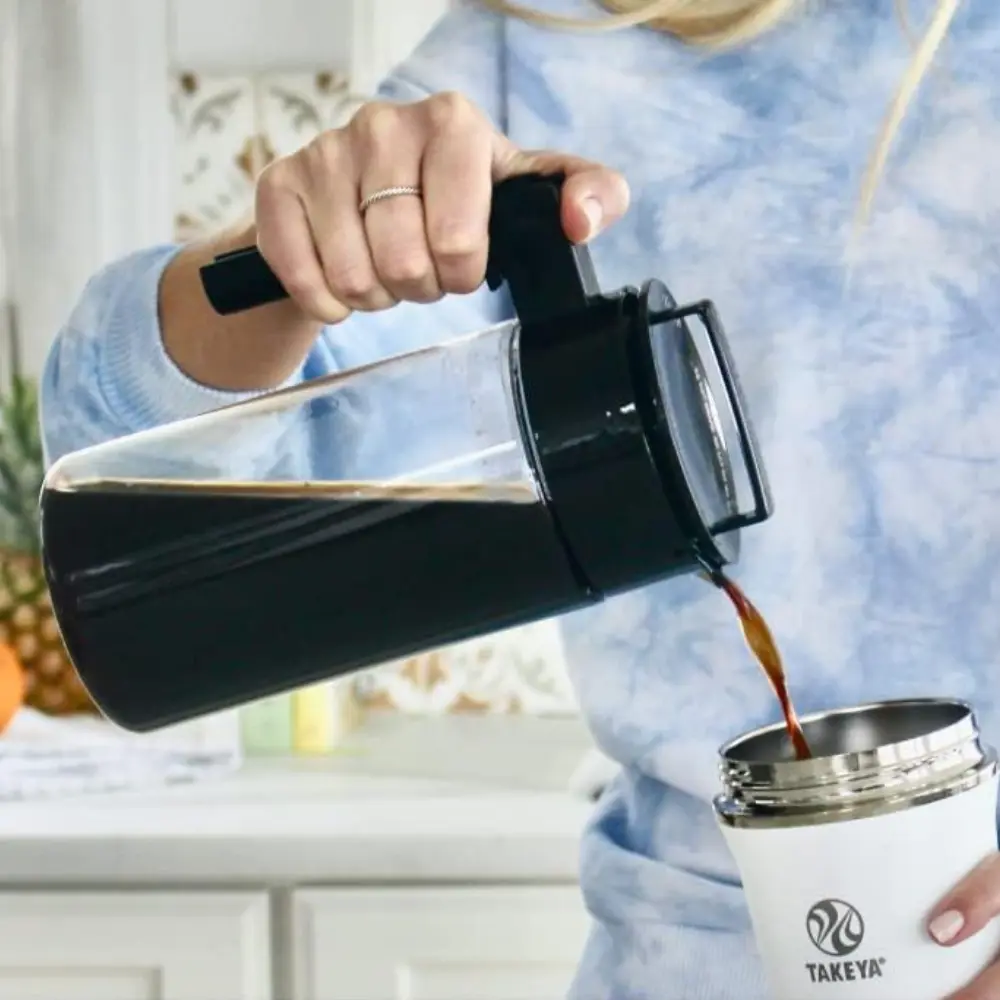
Before you start your brewing journey, it’s important to gather the essential tools. You don’t need a state-of-the-art kitchen or pricey equipment; a few basic tools will do:
- Cold Brew Coffee Maker: While you can use any large jar or French press, a dedicated cold brew coffee maker can simplify the process. These brewers are designed to facilitate steeping and straining, making the process fuss-free and easy to clean up.
- Coffee Grinder: To achieve the optimal flavor, it’s best to start with whole coffee beans and grind them yourself. The grind size should be coarse, similar to breadcrumbs.
- Scale or Measuring Cup: To get the right balance between coffee and water, accurate measurements are crucial.
- Quality Water: Since coffee is 98% water, the quality of water you use will directly influence the taste of your brew.
Step-by-Step Guide to Brewing Your Own Cold Brew
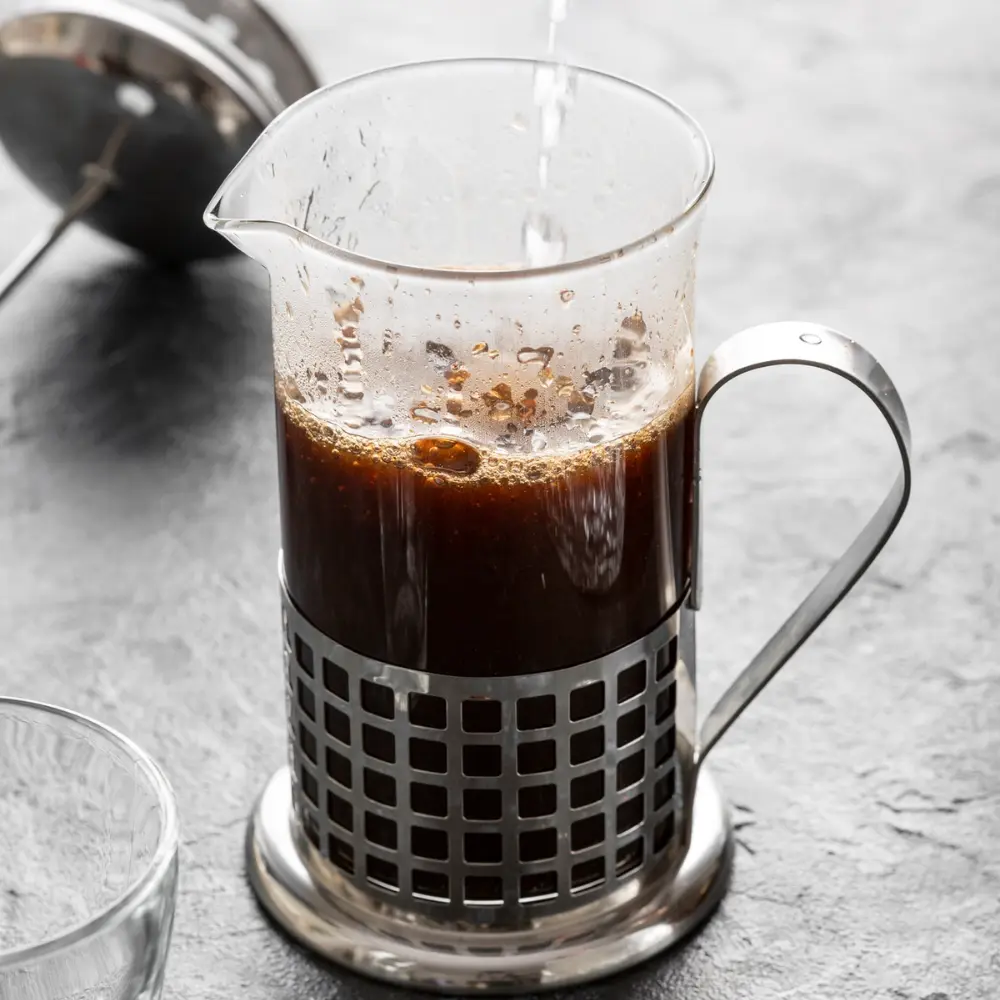
Now that you have all the necessary equipment, let’s get into the brewing process:
- Measure Your Coffee and Water: The generally recommended cold brew ratio is 1:5, meaning for every one part coffee, you use five parts water. Adjust this ratio to your liking, but remember, this will produce a concentrate that you’ll dilute later.
- Grind Your Coffee Beans: Achieve a coarse grind, akin to the texture of breadcrumbs. This size allows for a slow and even extraction, perfect for this brewing method.
- Combine and Stir: Add your ground coffee to the brewing vessel, followed by water. Give the mixture a gentle stir to ensure all grounds are thoroughly wet.
- Steep: Let the mixture steep at room temperature or in the refrigerator for about 12 to 24 hours. The longer it steeps, the stronger the flavor.
- Strain: After steeping, strain the mixture using a fine-mesh sieve, cheesecloth, or the filter provided by your brewer to remove the coffee grounds.
- Dilute and Serve: The result is concentrated coffee. Dilute it with water or milk to your liking, then pour it over ice and enjoy!
If you own a French Press, check out our guide on how to make cold brew in a French press
Tips for Perfecting Your Brewing Technique
Mastering the art of this brewing method is about experimentation and fine-tuning. Here are some tips to perfect your technique:
- Experiment with Different Coffee Beans: Every type of coffee has unique flavor profiles which are highlighted in this brewing process. Don’t be afraid to try different types and roast levels.
- Adjust Your Brewing Time: While 12 to 24 hours is generally recommended for steeping, you can adjust this to suit your taste preference. A longer steep time results in a bolder, more robust flavor.
- Store Properly: Keep your drink’s concentrate refrigerated in an airtight container to preserve its freshness. It can stay fresh for up to two weeks.
With these insights and tips at your disposal, you’re well on your way to mastering the art of this lovely coffee drink. Enjoy the process and the delicious results!
Best Cold Brew Coffee Maker Options
Embarking on the journey of brewing your own cold brew at home can be a rewarding experience, not just for the taste buds, but also for the sense of accomplishment that comes with perfecting your own brew. Choosing the right coffee maker plays a crucial role in this process. Let’s delve into the features, pros, and cons of three top-rated cold brew coffee makers in the market.
Mueller Cold Brew Coffee Maker

The Mueller Cold Brew Coffee Maker is a professional-grade kitchen gadget for those looking to achieve a rich, smooth brew at home. It allows for an impressive 65% reduction in acidity compared to hot coffee, and the large 2L capacity keeps the brew fresh for up to two weeks.
Featured Highlights:
- Excellent extraction through a stainless steel filter
- 2L capacity
- Hermetically sealed, leak-proof lid
- Detachable mesh core
Pros:
- The pitcher is made of non-toxic tritan plastic which mimics glass but provides better resilience.
- Versatile in brewing: Can be used for creating flavored brews and cocktails.
Cons:
- May require frequent cleaning for optimal performance.
- The size might not be suitable for small refrigerators.
No products found.
OXO Good Grips Cold Brew Coffee Maker

The OXO Good Grips Cold Brew Coffee Maker provides a smooth infusion process through its Rainmaker feature and convenient filtration activation. This brewer is user-friendly, making it an excellent choice for this brewing method novices and aficionados.
Featured Highlights:
- Innovative Rainmaker feature for even water distribution
- Automatic stop feature to prevent spills
- Reusable mesh filter
Pros:
- Convenient to use with a stopper that doubles as a measuring tool.
- Easy cleaning due to its disassemblable design.
Cons:
- A smaller capacity compared to other options.
- Optional paper filters for extra filtration might incur an additional cost
- Brews smooth, delicious low-acid coffee concentrate, which can be used to prepare hot or cold coffee
Coffee Bear Cold Brew Coffee Maker
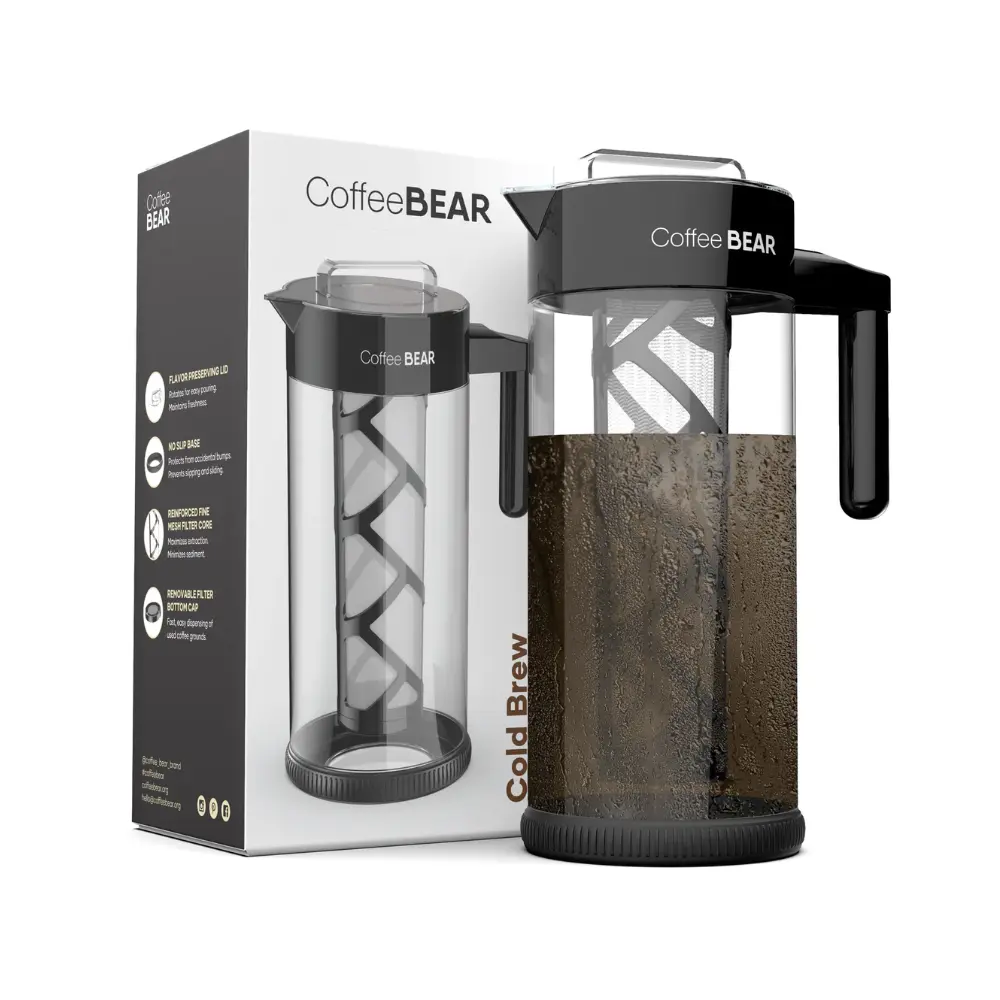
The Coffee Bear Cold Brew Coffee Maker serves up a less acidic, full-bodied cup of this coffee drink and has the added advantage of being able to double as a tea infuser. This brewer is not just a utilitarian addition to your kitchen but also adds an aesthetic appeal.
Featured Highlights:
- Large capacity of 1.3 Liters
- Multi-functional mesh filter for both coffee and tea brewing
- Non-slip silicone base
Pros:
- The pitcher’s size fits easily in refrigerator doors despite its large capacity.
- Dishwasher safe, facilitating easy cleanup.
Cons:
- The detachable silicone base might get lost easily.
- A finer grind of coffee might slip through the mesh filter, requiring additional filtration.
- ➤ Yields Tastier, Less Acidic Coffee – In just 12 to 24 hours, you get a smooth concentrate with more caffeine and 60% less acidic than traditionally brewed hot coffee. The glass coffee carafe has a flavor-locking lid to seal flavor and keep your drink fresh.
Coffee Gator Cold Brew Coffee Maker
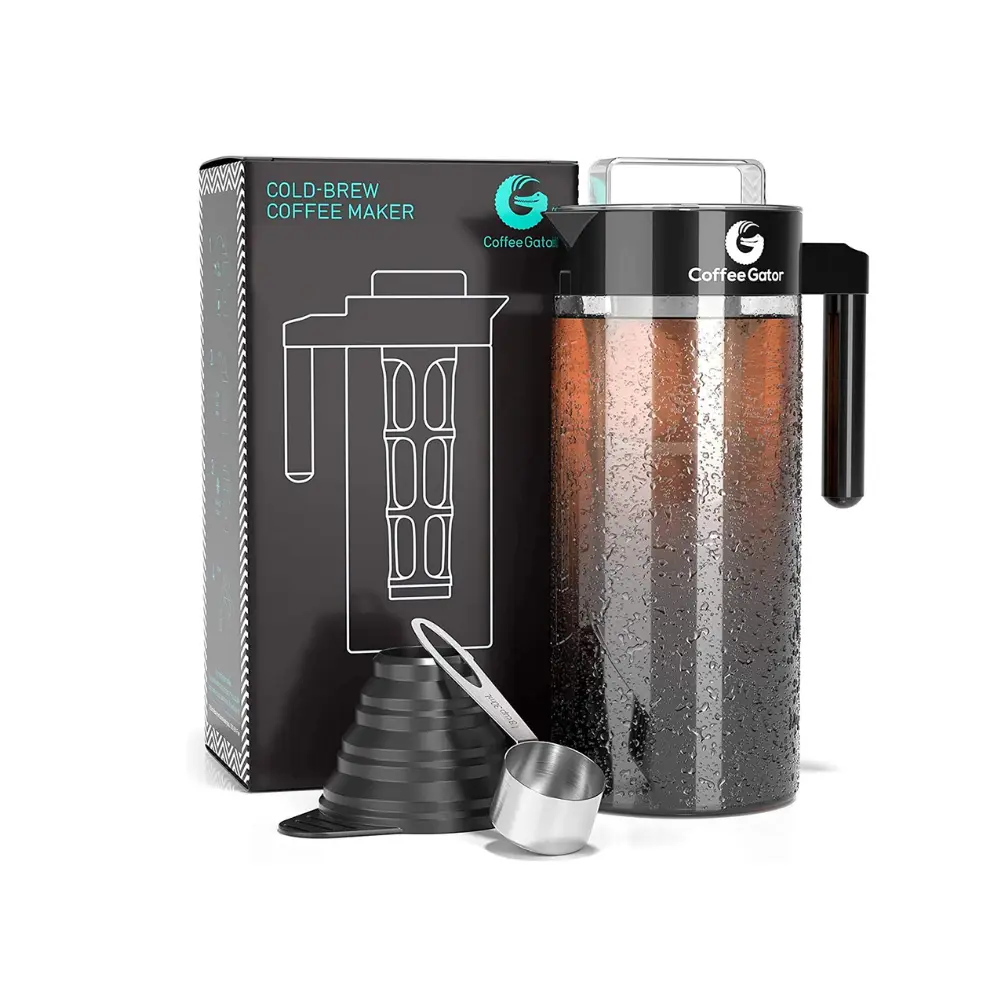
The Coffee Gator Cold Brew Coffee Maker showcases an efficient design for effortless brewing. With a high-quality, ultra-fine mesh filter and a strong glass carafe, this brewer produces a rich and sediment-free cold brew concentrate that is as pleasing to the palate as it is easy to make.
Featured Highlights:
- Durable and temperature-resistant Borosilicate glass carafe
- Ultra-fine mesh filter
- BPA-free construction
- Easy-to-clean design
Pros:
- The brewer is simple to use and requires minimal effort for cleanup.
- It uses reusable components, promoting environmental sustainability.
- The brewing process can be completed within minutes, and the resulting concentrate can last for weeks.
Cons:
- The glass construction, while elegant and durable, might require careful handling to prevent breakage.
- EASY TO USE: Our iced coffee maker kit features a strong glass carafe with an ultra-fine mesh filter to trap sediment – all you need to do is add your grounds, pour in cold water, chill, and enjoy.
Cuisinart DCB-10P1 Automatic Cold Brew Coffeemaker
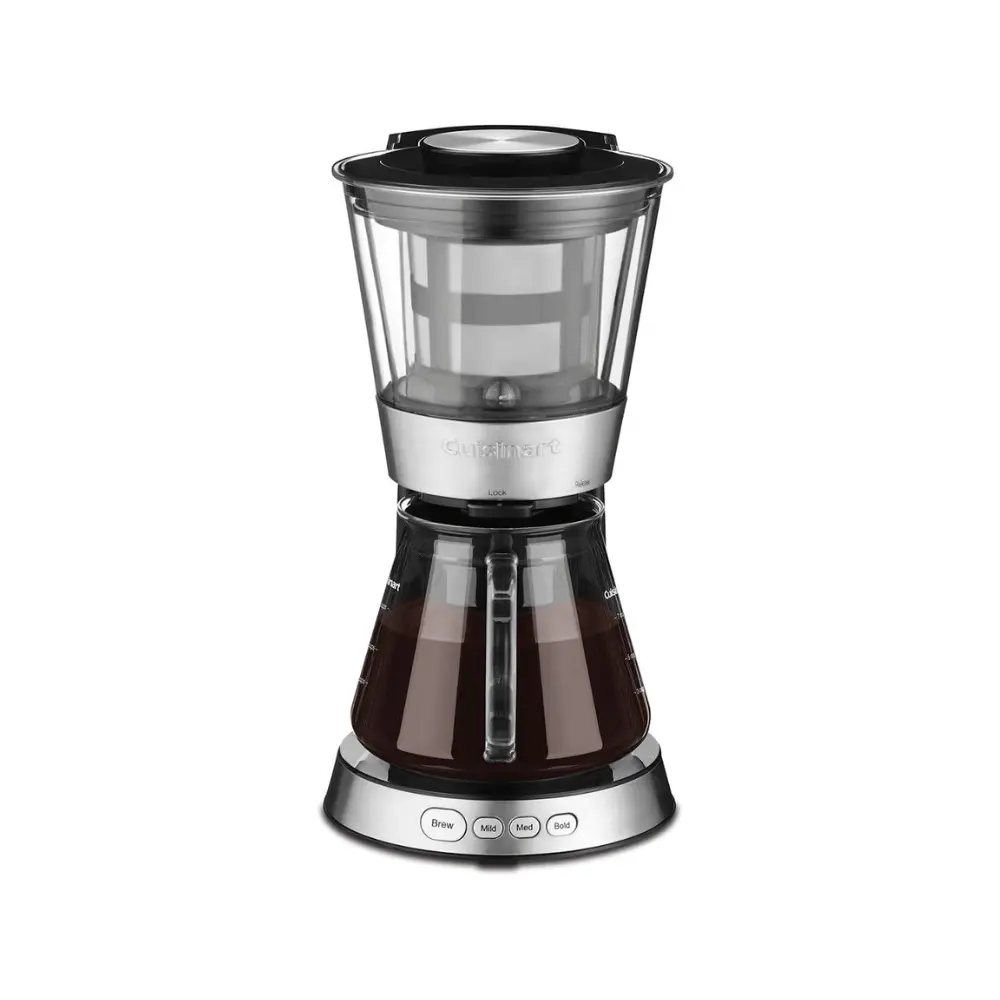
The Cuisinart DCB-10P1 Automatic Cold Brew Coffeemaker is designed to elevate your brewing experience. With the ability to brew a seven-cup carafe of ready-to-drink cold brew in just 25 to 45 minutes, this coffeemaker merges convenience and quality in one device.
Featured Highlights:
- Strength Selector for customizable brew strength
- Clear brewing chamber for process visibility
- Removable water tank and coffee filter basket
- Coffee release lever with indicator light
Pros:
- This coffee maker provides fast brewing.
- The Strength Selector allows you to personalize the brew to your taste preferences.
- The glass carafe can be used for brewing and storing the coffee in the refrigerator for up to two weeks.
Cons:
- This device may require more cleaning compared to simpler designs.
- With its larger dimensions, it may take up more counter space than other coffee makers.
- 7-cup glass carafe with removable stainless steel filter lid makes ready-to-drink cold brew Coffee in as little as 25-45 minutes
The Impact of Coffee Beans and Roasts
The quality and characteristics of the coffee beans used can greatly influence the final flavor profile of your brew. Both the choice of coffee beans and the roast level play significant roles in determining the taste, aroma, and body of this beverage. Here, we will explore the optimal beans for this brewing method, the influence of the roast profile on the final product, and how geographic origins can imbue unique characteristics to the drink. Ready to explore these fascinating elements? Let’s dive in!
The Perfect Beans for Brewing

Selecting the right coffee beans for this brewing technique is largely a matter of personal preference, as different beans offer unique flavors and aromas. That being said, there are certain traits to look for when selecting beans for this method:
- Freshness: Opt for freshly roasted beans over pre-packaged ground coffee. Freshly roasted beans retain their natural oils and flavors, giving your brewing a more vibrant taste.
- Flavor Profile: Beans with inherent sweetness and low acidity are typically recommended for this brewing method. This helps create a smooth, sweet, and well-rounded brew.
- Grind Size: For this brewing technique, a coarse grind is ideal. This allows for a slow extraction process, resulting in a flavorful and less acidic brew.
The Influence of Roast Profile on Cold Brew Taste
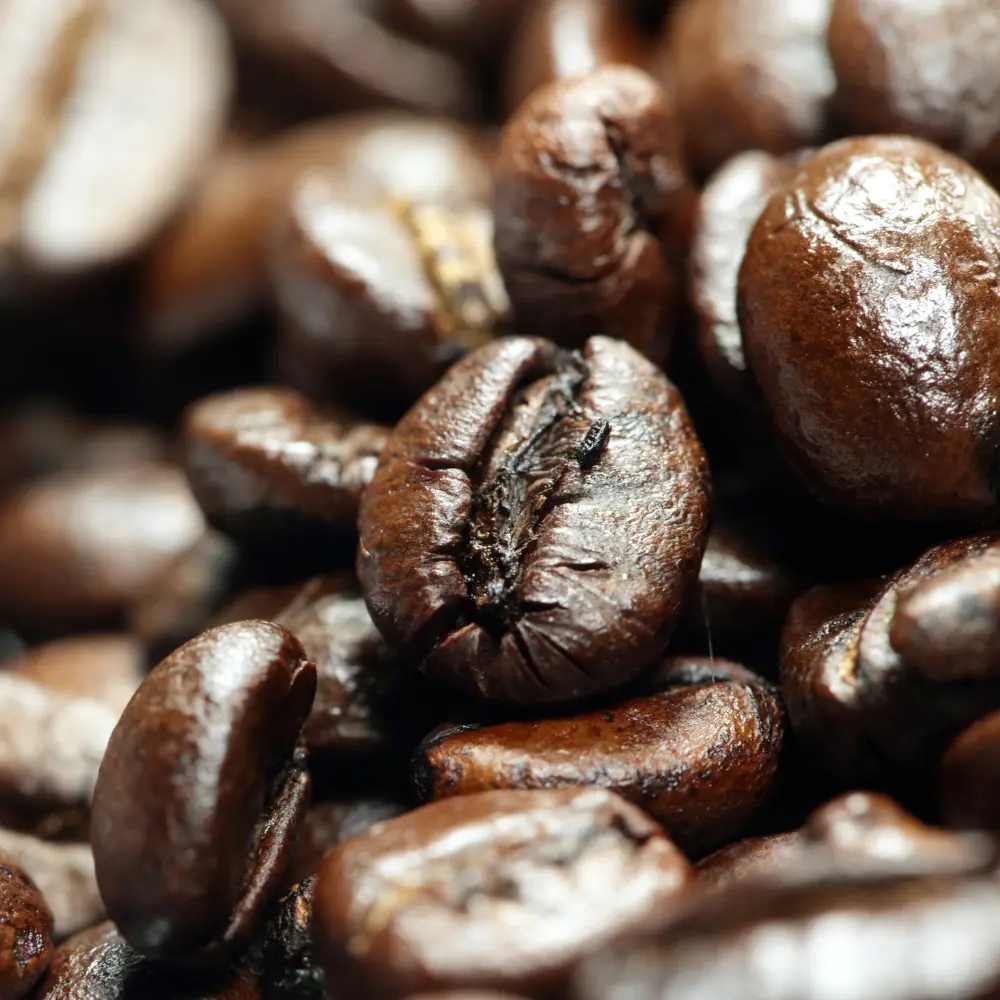
The roast profile of your coffee beans can significantly impact the flavor of your beverage. The roast level influences the balance between acidity, bitterness, and sweetness in your brew:
- Light Roasts: These offer more acidity and are often more complex and fruity. However, when used for cold brewing, these flavors can sometimes be subtle due to the cold extraction process.
- Medium Roasts: A middle-ground option, medium roasts retain some of the beans’ original flavors while introducing flavors developed during roasting. They tend to produce well-balanced and smooth brews.
- Dark Roasts: These are less acidic, with flavors leaning towards the bitter and robust side. Dark roasts are excellent for a bold, full-bodied cold brew with notes of chocolate and nuts.
Geographic Origins and Their Effects on Flavors
The origin of your coffee beans can have a marked effect on the final taste of your coffee drink. Beans from different regions come with distinctive flavor profiles:
- African Beans: Coffee from regions like Ethiopia and Kenya often exhibits fruity and floral notes, adding a vibrant complexity to your brew.
- South American Beans: Beans from Colombia, Brazil, and other South American countries typically showcase chocolatey, nutty flavors with a mild fruitiness.
- Asian Beans: Countries like Indonesia and Vietnam produce beans with earthy, spicy, and sometimes smoky flavors.
Exploring beans from various regions and experimenting with different roasts can elevate your experience, allowing you to enjoy a diverse array of flavors and aromas with every sip.
Cold Brew Coffee Variations and Recipes
The world of this distinctive beverage extends far beyond a basic brew. It’s a versatile base that lends itself to a variety of creative adaptations and tantalizing recipes. Here, we’ll delve into some popular variations of this beverage, including the classic Iced Cold Brew, the creamy and effervescent Nitro Cold Brew, and the flexible Cold Brew Concentrate. Each of these variations caters to a different palette and mood, demonstrating the sheer versatility of this delectable drink. Are you ready to expand your coffee horizons? Let’s get started!
Iced Cold Brew: The Ultimate Summer Cooler
An iced cold brew is the quintessential summer drink, offering a refreshing twist to your regular coffee routine. It’s simple yet delightful, and incredibly easy to prepare. Here’s a basic recipe:
- Prepare your cold brew concentrate following the instructions in our brewing guide.
- Fill a tall glass with ice.
- Pour the cold brew concentrate over the ice, leaving some space at the top. The ratio of concentrate to water or milk can be adjusted according to your taste preference.
- Add cold water or milk to dilute the concentrate. Stir well.
- Sweeten if desired, and your refreshing beverage is ready to enjoy!
Nitro Cold Brew: Creamy and Velvety Delight

Nitro cold brew is a unique variation that involves infusing this delectable coffee with nitrogen gas, giving the coffee a rich, creamy texture and a naturally sweet flavor. It’s served straight from the tap and poured into a glass, much like a beer. The resulting beverage is smooth, velvety, and has a beautiful cascade effect. While typically made in coffee shops with specialized equipment, home brewers can replicate this using a whipped cream dispenser or a home nitro brew machine.
Cold Brew Concentrate: Versatility in a Bottle
The beauty of this brewing method lies in its versatility, and nothing exemplifies this better than this drink’s concentrate. This potent brew serves as a base that you can transform into various coffee creations. It’s perfect for those busy mornings or for whipping up coffee cocktails for an evening gathering.
Making this drink’s concentrate is similar to making regular cold brews but with a higher coffee-to-water ratio. For a strong concentrate, a 1:3 or 1:4 ratio can be used. Remember, this strong brew is meant to be diluted before consumption. Store it in an airtight container in the refrigerator and use it as needed.
The versatility of this beverage is one of its most exciting aspects, allowing coffee enthusiasts to experiment and create a variety of beverages. It’s more than just a coffee; it’s a platform for creativity and personalization.
Cold Brew Coffee in the World of Gastronomy
This coffee is no longer just a drink; it has become a cultural phenomenon that has seeped into different aspects of gastronomy. From the rise of cold brew-dedicated coffee shops to an impressive array of innovative recipes, cocktails, and food pairings, this beverage is redefining the culinary scene. Ready to dive into the gastronomic world of cold brew coffee? Let’s explore!
The Rise of Cold Brew Coffee Shops
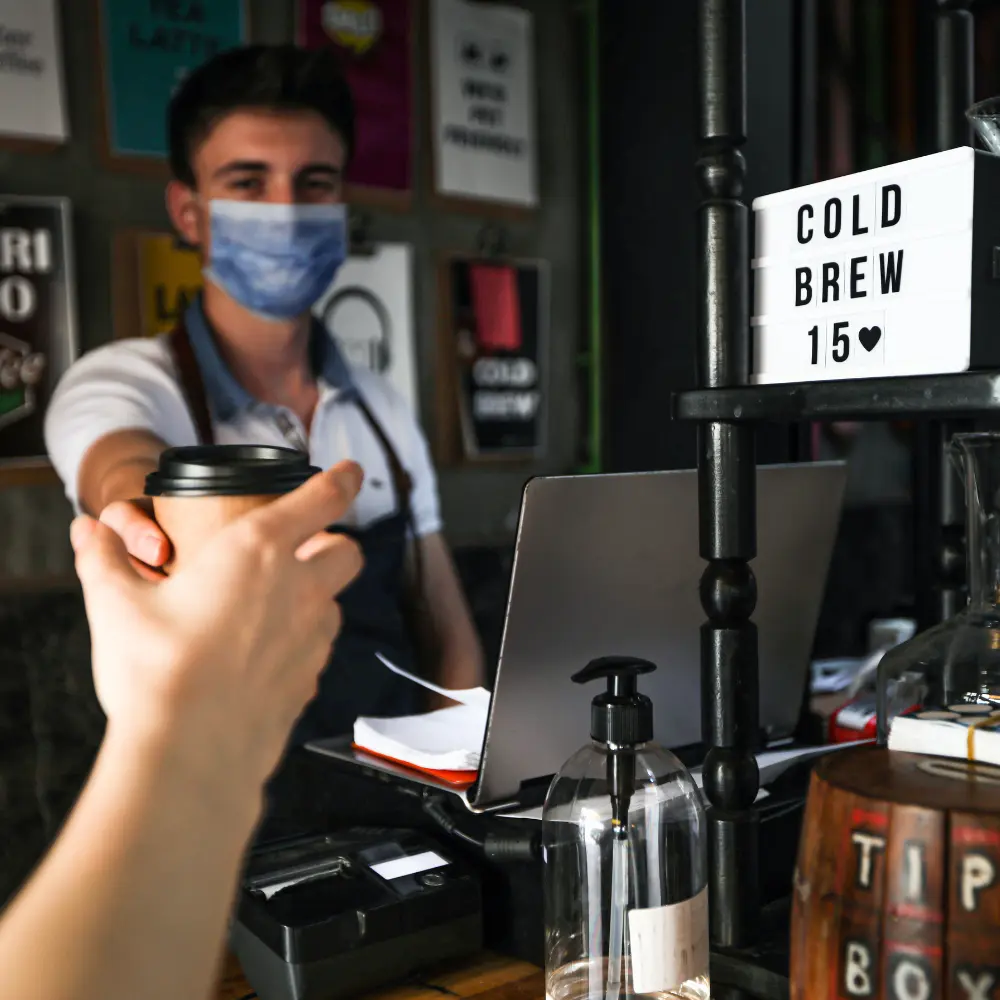
In response to the increasing demand for this coffee drink, a wave of specialty coffee shops has emerged, with this brewing method as their star offering. These establishments often feature unique brewing methods, various blends, and artisanal variations of the drink. Some even offer tasting flights, allowing customers to sample different types of this distinctive beverage. The rise of these specialized coffee shops reflects the growing appreciation and fascination for this coffee drink.
Innovative Cold Brew Recipes to Try at Home
This concoction’s rich flavor and versatility make it an excellent ingredient for culinary innovation. Apart from traditional iced coffee or cold brew lattes, there are plenty of other creative ways to incorporate this beverage into your kitchen:
- Cold Brew Smoothies: Add a kick of caffeine to your morning smoothie by incorporating this beverage. It pairs well with bananas, cocoa powder, almond milk, and a touch of honey.
- Cold Brew Ice Cream: For a sophisticated dessert, try making homemade coffee ice cream using this drink. Its concentrated flavor works brilliantly in this sweet treat.
- Cold Brew Glaze: Mix cold brew concentrate with powdered sugar to create a coffee glaze for donuts or cakes.
Cold Brew Cocktails: Mixing Coffee and Spirits
In the world of mixology, this beverage is a prized ingredient, bringing depth and complexity to a range of cocktails. Let’s dive deeper into the world of coffee-infused mixology with step-by-step guides to three captivating cocktails.
Cold Brew Martini
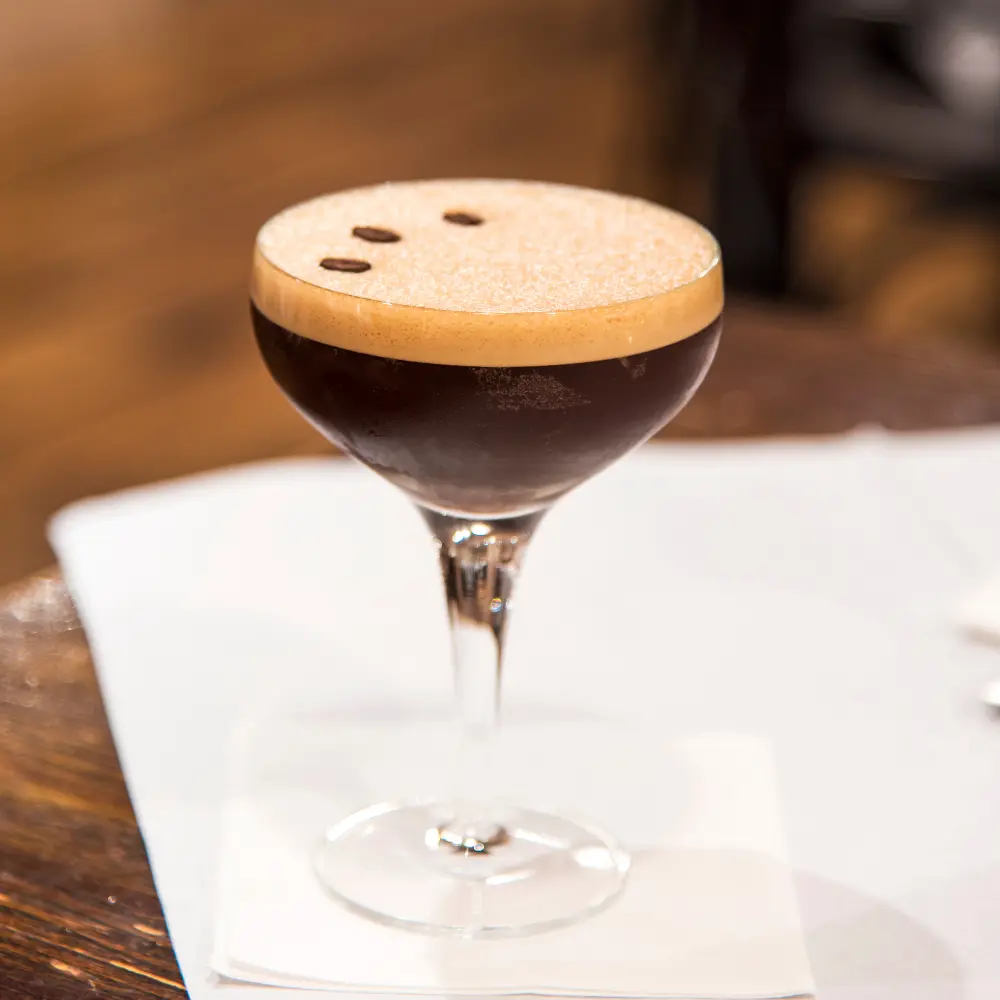
This sophisticated cocktail is perfect for late-night gatherings or a classy dinner.
You’ll need:
- 1.5 oz cold brew concentrate
- 1.5 oz vodka
- 1 oz coffee liqueur
- Ice cubes
- 1 coffee bean for garnish (optional)
Instructions:
- Fill a cocktail shaker with ice.
- Pour in the cold brew concentrate, vodka, and coffee liqueur.
- Shake well for 15-20 seconds until well chilled.
- Strain into a chilled martini glass.
- Garnish with a coffee bean and serve immediately.
Coffee Negroni

This intriguing aperitif is a unique twist on the classic Negroni, with cold brew concentrate replacing the gin.
You’ll need:
- 1 oz cold brew concentrate
- 1 oz sweet vermouth
- 1 oz Campari
- Ice cubes
- 1 orange peel for garnish
Instructions:
- Add the cold brew concentrate, sweet vermouth, and Campari into a mixing glass filled with ice.
- Stir well for about 20 seconds until well combined and chilled.
- Strain into a glass over ice.
- Garnish with an orange peel and serve.
Irish Cold Brew

This rich and creamy cocktail is an excellent after-dinner drink.
You’ll need:
- 2 oz cold brew coffee
- 1.5 oz Irish whiskey
- 0.5 oz simple syrup
- 1 oz cream
- Ice cubes
Instructions:
- In a glass filled with ice, add the coffee, Irish whiskey, and simple syrup. Stir well.
- Slowly pour cream over the back of a spoon held just above the drink’s surface so it floats on top.
- Serve immediately, and enjoy the layered effect.
As with all cocktails, these should be enjoyed responsibly. The complex flavors of these beverages make them a delightful treat for any coffee enthusiast. Try them out at your next gathering, or have a fun evening experimenting with these mixology recipes at home. Enjoy!
Pairing Food with Cold Brew: A Guide for Epicureans
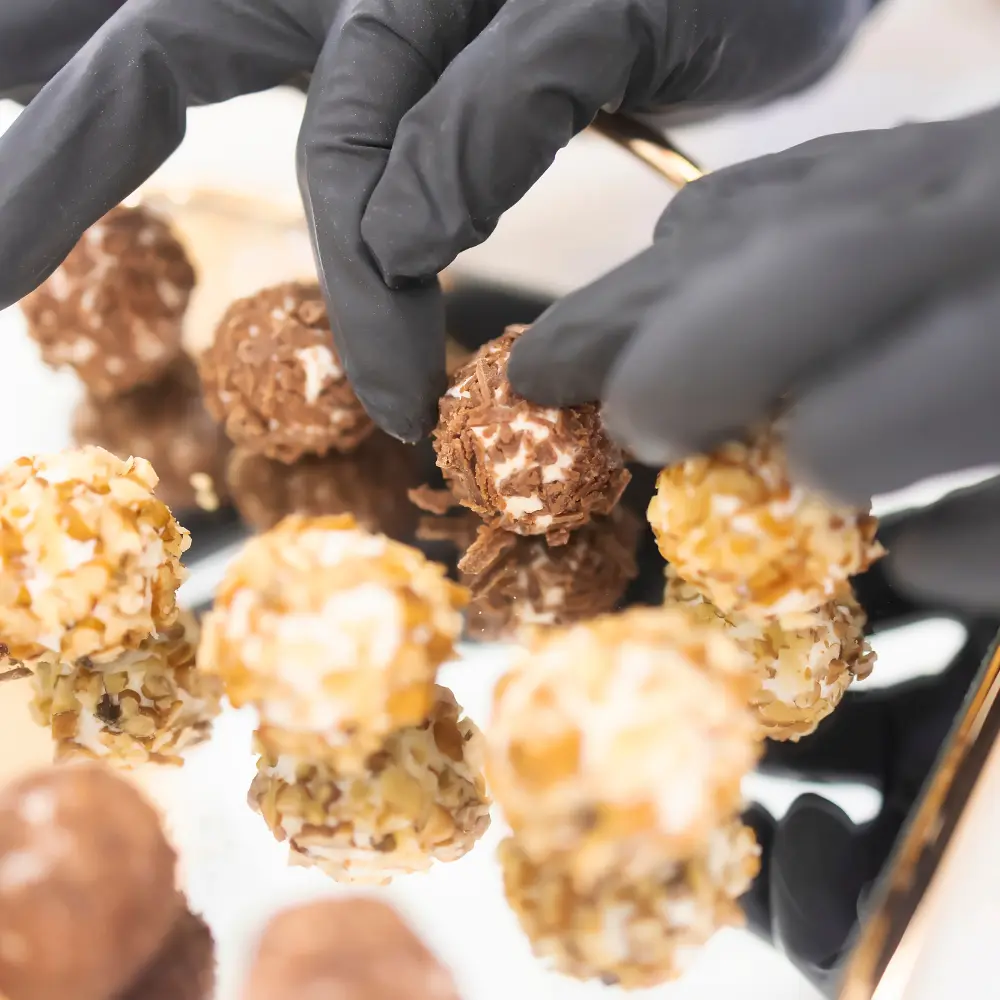
Pairing food with this lovely beverage can enhance the enjoyment of both. Here are a few tips for successful pairing:
- Sweet Treats: this drink’s low acidity and natural sweetness pair excellently with pastries, donuts, or chocolate.
- Savory Dishes: For a contrast of flavors, try pairing your drink with spicy or salty foods, such as a savory breakfast quiche or spicy chicken wings.
- Cheese: Creamy and nutty cheeses, such as Brie or Gouda, pair wonderfully with this beverage’s smooth and sweet notes.
The world of this concoction in gastronomy is a fascinating place to explore, offering endless possibilities for creativity and enjoyment.
The Refreshing Duel: Cold Brew vs Iced Coffee
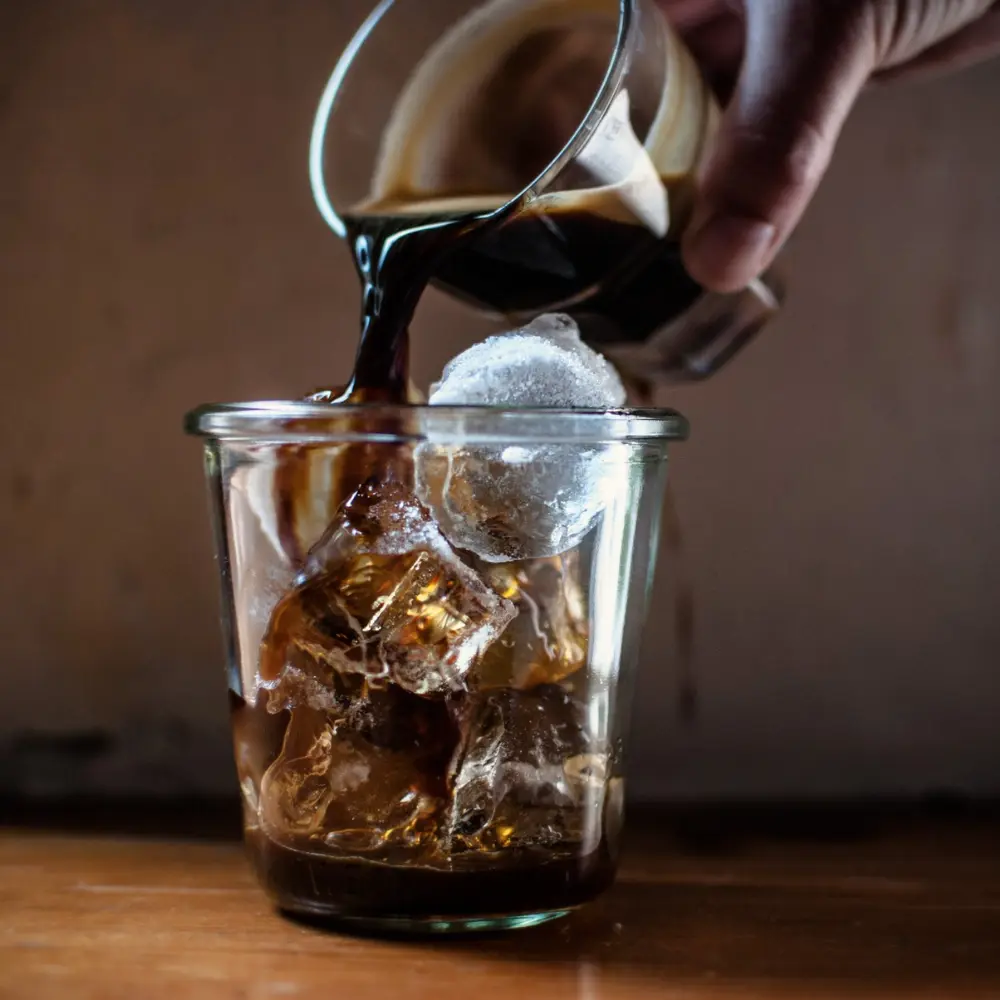
As the temperature rises, the demand for a cool, caffeinated pick-me-up does too. Two popular contenders in this arena are cold brew and iced coffee. Though they may seem similar, key differences distinguish these beverages, shaping their taste profiles, brewing methods, and caffeine content.
- Brewing Method: The brewing process is the core differentiator between these two drinks. Cold brew, as the name suggests, is brewed with cold or room-temperature water over a lengthy period, often 12-24 hours. This slow, cold infusion extracts the coffee’s flavors and aromas differently than hot brewing methods, leading to a unique taste and chemical profile. On the other hand, iced coffee is essentially hot coffee that has been cooled down and poured over ice. Its production involves brewing coffee in a regular, hot method, allowing it to cool, and then serving it chilled.
- Flavor Profile: The disparity in brewing methods results in distinct flavor differences. Cold brew typically offers a smooth, full-bodied, and less acidic taste due to its slow extraction process, which reduces the extraction of the coffee’s natural oils and acids. Iced coffee retains more of the traditional, vibrant, and bright flavors of hot coffee. It tends to be more acidic due to the hot brewing process, which can sometimes result in a slightly bitter taste.
- Caffeine Content: It’s worth noting that the caffeine content in both beverages can vary greatly depending on factors like the type of coffee bean, the brew time, and the coffee-to-water ratio. However, cold brew often contains more caffeine than iced coffee due to its higher coffee-to-water ratio and longer brewing time.
- Preparation Convenience: In terms of ease and convenience, iced coffee takes the lead as it can be quickly brewed with hot water and then cooled. Cold brew, conversely, requires forethought and time due to its long steeping process.
- Versatility: Both drinks showcase their versatility in unique ways. Cold brew’s smooth and rich taste makes it suitable for a variety of culinary applications, including coffee-flavored desserts and cocktails. Meanwhile, iced coffee, with its bright and robust flavors, can be customized with various additions such as flavored syrups, milk, or cream.
Overall, the choice between these two beverages largely boils down to individual preferences concerning taste, acidity, brewing convenience, and the desired caffeine kick. Both drinks offer a refreshing twist to the traditional hot cup of joe, each with its own distinctive appeal and flavor profile.
Conclusion
In conclusion, the question “What is cold brew coffee?” opens up a world of exploration into a unique method of coffee preparation. This beverage, steeped in cold water over an extended period, offers a less acidic and smoother experience that may prove to be a refreshing twist to your caffeine fix. The beauty of this drink extends beyond its taste; it provides a creative canvas for coffee lovers to experiment with flavors, techniques, and even food pairings.
Learning how to make this refreshing drink at home is an engaging endeavor, enhanced by the range of specialized coffee makers available in the market. Whether you wish to savor it as a stand-alone drink, whip up innovative recipes, or incorporate it into an elegant cocktail, this versatile brew certainly elevates the coffee-drinking experience.
Remember, exploring the world of coffee is all about savoring the journey. So, take your time, experiment with brewing times and coffee grinds, and find that perfect blend that stimulates your senses and resonates with your personal preferences. Here’s to many refreshing moments with your delectable coffee drink!
FAQ
What type of coffee beans is best for cold brew?
Coarse-ground, medium to dark roast coffee beans are typically preferred for cold brew due to their robust flavor and low acidity.
How long can you store cold brew coffee?
Cold brew coffee can be stored in the refrigerator for up to two weeks while retaining its fresh flavor.
What is the ratio of coffee to water for cold brew?
A common ratio for this beverage is 1:5, that is one part coffee to five parts water. However, this can be adjusted based on personal preference.
Can you make cold-brew coffee with regular coffee grounds?
Yes, you can use regular coffee grounds for cold brew, but a coarse grind is typically recommended for optimal flavor extraction.
